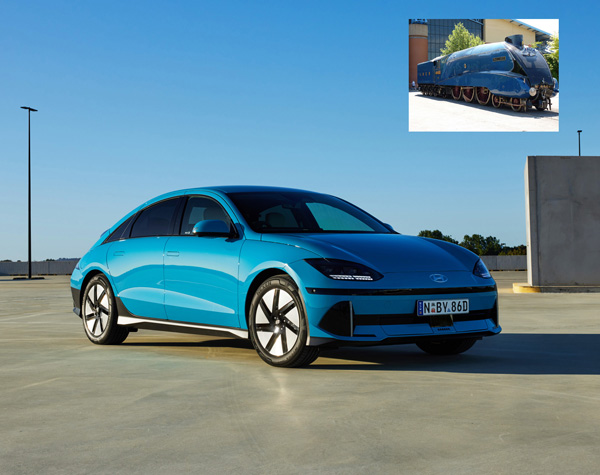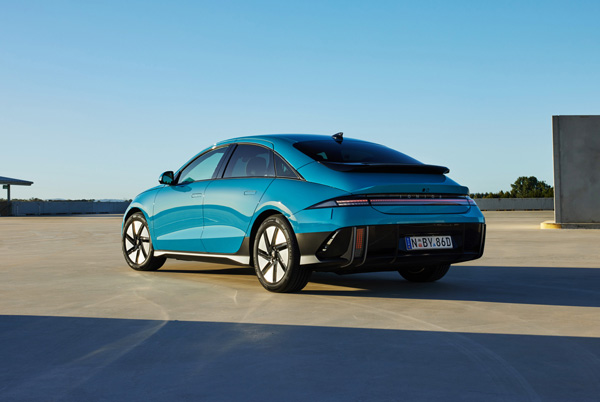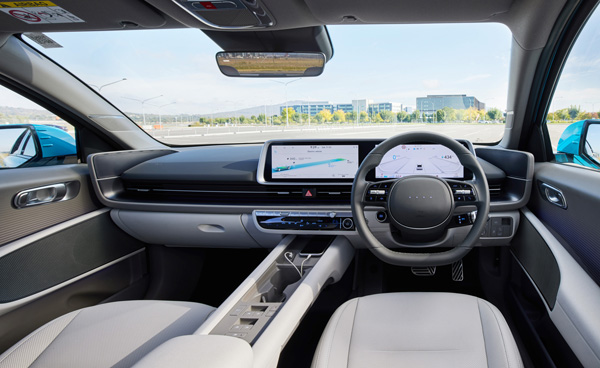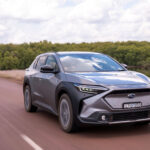
At a mere year or so old, the Ioniq 6 electric vehicle is already among hallowed
company. Back in the 1930s, steam locomotives were battling for bragging rights all
over British railway routes.
The height of the Art Deco period saw the birth of the A4 Class streamliner (‘streak’ to
the young trainspotters of the day), designed by Sir Nigel Gresley, with its sleek profile,
spats and aerodynamic surfaces based on the Bugatti racing cars of the day.
Indeed, Sir Nigel, a friend of Ettori Bugatti, spent time in France studying his work,
incorporating it into the A4s, one of which, the Mallard, still holds the world speed
record of 126 mph (200 km/h) for a steam loco. It’s ironic that the record was set on a
run ostensibly to test a new braking system.
Fast forward to today, with Hyundai’s new Ioniq 6 EV design measuring up to the
streak. At Cd 0.21, the swoopy sedan is the most aerodynamic vehicle the company
has made, resulting in a claimed zero-to-100 km/h acceleration time of 5.1 seconds for
the twin-motor all-wheel-drive Techniq and Epiq models on to a top speed of a
‘Mallardian’ 180 km/h-plus. No slouch.
At first glance the Ioniq 6 stirred memories from this former young railway enthusiast of
the ‘ten o’clock streak’ taking on Copley Hill after steaming out of Leeds Central Station
on the up line to London. The sleek profile does it.

However, that’s where the heavily polluting fossil fuel burning ‘iron horse’ is left far
behind by the iconic Ioniq 6. First of all, there are fewer emissions with the EV – none,
in fact.
And much of the material used in the Ioniq 6 is eco processed genuine leather,
recycled and bio-material fabrics, bio paint, recycled fish-net carpets and mats, and
recycled pigment paint.
Roadside support is available for the first two years and beyond each time the car is
serviced at a Hyundai dealer and up to ten years of map updates.
Coming in three variants, Dynamiq, Techniq and Epiq, on test was the first mentioned,
which sells for $74,000, plus on road costs. A rear-wheel drive sedan, it is trumped by
the two all-wheel drive versions costing $83,500 and $88,000 respectively.
STYLING
As well as recalling the deeds of a famous engineering icon, Hyundai says the
innovative streamlined design is a rendering of smooth curves of perfectly weathered
stone. Sleek exterior lines are further enhanced with flush-fitting door handles which
pop-out automatically when unlocked, while 18-inch aero wheels, with six offset panels
windmill style, present a perfect base.
The car measures 4855 mm in length, 1880 mm width and 1495 mm height, with a
2950 mm wheelbase, similar to Hyundai’s petrol-powered Sonata, but 50 mm closer to
the road and with 110 mm more between the wheels.
It did attract a somewhat cynical comment from one onlooker relating to the car’s
fulsome rear. With a continuous strip of LED taillights and double-decker rear spoiler,
there was the suggestion of an automotive Botox-style cosmetic enhancement.
INTERIOR
Despite being entry-level the Dynamiq is well equipped, with standard features
including, head-up windscreen display, dual 12.3-inch display monitors, 10-way
powered driver and front passenger seats, eight-speaker Bose audio, wired Apple
CarPlay and Android Auto, multi-Bluetooth connectivity, Blue Link Connected Car
Services and a powered boot lid.

Seats are of eco-friendly material, as are recycled fish-net carpets and mats. Seating
up front is comfortable and spacious, unlike behind which has limited headroom thanks
to the curvy roofline and no toe room because the front seats rest on the floor.
Storage includes a 401-litre rear boot, with underfloor area, and 45 litre front boot, the
latter enough to take the charging tackle.
INFOTAINMENT
The dual 12.3-inch screens provide stacks of info and once mastered (time consuming)
the system is quick, responsive and fairly easy to navigate.
Bluelink connected car service allows users to set a charging time, and pre-set the
vehicle’s climate control to take advantage of off-peak electricity; also, remotely monitor
the vehicle’s distance to empty and can restart charging if required.
The app allows the owner to find EV charging stations and send the address to the
car’s sat navigation. A tool will show on a map the driveable radius with 80 and 100 per
cent battery charge levels.
ENGINES / TRANSMISSIONS
The single motor, front-wheel drive Dynamiq stumps up more than 600 kilometres
range from its 77.4 kWh battery, which, the maker says, can go from 10 to 80 per cent
in just 18 minutes on an ultra-fast 350kW charger. A home or work wall box will take
almost 12 hours.
The rear-drive Dynamiq model takes a claimed 7.4 seconds to reach 100 km/h from
rest.
SAFETY
Hyundai SmartSense is a super suite of safety systems that can intuitively take care of
car and occupants with all-round aplomb. Included are forward collision avoidance,
lane change assist, blind spot monitor, speed limit warning, smart cruise control,
surround view, rear occupant alert and lots in between. Five-star safety rating is a
given.
DRIVING
The Dynamiq is powered by a single rear-mounted electric motor developing 168 kW
and 350 Nm, good for a claimed 0-100km/h time of 7.4 seconds, and 614 km of
claimed driving range on Europe’s WLTP lab-test protocol.
The transmission is controlled by the twist of a steering wheel-mounted stalk on the
right, while drive modes – eco, normal and sport – are selected via a single button on
the left of the steering wheel rim.
An i-Pedal mode allows for single-pedal driving that can slow and bring the car to a
stop without touching the brake pedal, creating more generative power, always a boon
in heavy city traffic.
There’s an eerie engine noise from under the bonnet, as in a bitter winter wind whistling
through a badly insulated medieval pile, does insinuate itself in the cabin.
However, there is all but a total absence of wind noise, but tyres do rumble on course
road surfaces.
No bother, the Bose sound system, on command, can fill the cabin with the sounds of
nature – calm ocean waves, for example, providing the soundtrack for the selectable
ambient lighting. Unfortunately, beeps and ding warnings ring out too often, disturbing
the otherwise relaxed atmosphere of the space.
Vehicle systems such as locking, air-conditioning and locating the car can be done
from a smartphone. Special features for EVs include scheduling charge times, finding
the nearest charging stations and remote viewing of charging status.
Over-the-air updates of controller software, free for ten years, means the Ioniq 6’s
systems can be upgraded to latest versions without visiting a service centre
SUMMARY
The Ioniq 6 Dynamiq? What’s not to like.
RATINGS
Looks: 9/10
Performance: 8/10
Safety: 8/10
Thirst: 8/10
Practicality: 8/10
Comfort: 7/10
Tech: 9/10
Value: 7/10
AT A GLANCE
MODEL LINE-UP
Ioniq Dynamiq 2WD $74,000
Ioniq Techniq AWD $83,500
Ioniq Epiq AWD $88,000
Note: These prices do not include government or dealer delivery charges. Contact your
local Hyundai dealer for drive-away prices.
SPECIFICATIONS (Ioniq 6 EV, automatic, RWD)
ENGINE:
Single electric motor, 77.4kWh lithium-ion battery
Combined energy consumption: Claimed 14.3 kWh / 100 km
Maximum Power: 168 kW
Maximum Torque: 350 Nm
Charging: 10-80 pc in 18 minutes
DRIVELINE: Single motor, rear-wheel drive
DIMENSIONS, WEIGHT AND CAPACITIES:
Length: 4855 mm
Wheelbase: 2950 mm
Width: 1880 mm
Height: 1495 mm
Turning Circle: 11.82 metres
Kerb mass: 1968 kg
Range: 614 km
BRAKES:
Front: Ventilated disc
Rear: Disc
STANDARD WARRANTY:
Five years / unlimited kilometres
Battery eight years / 160,000 kilometres











